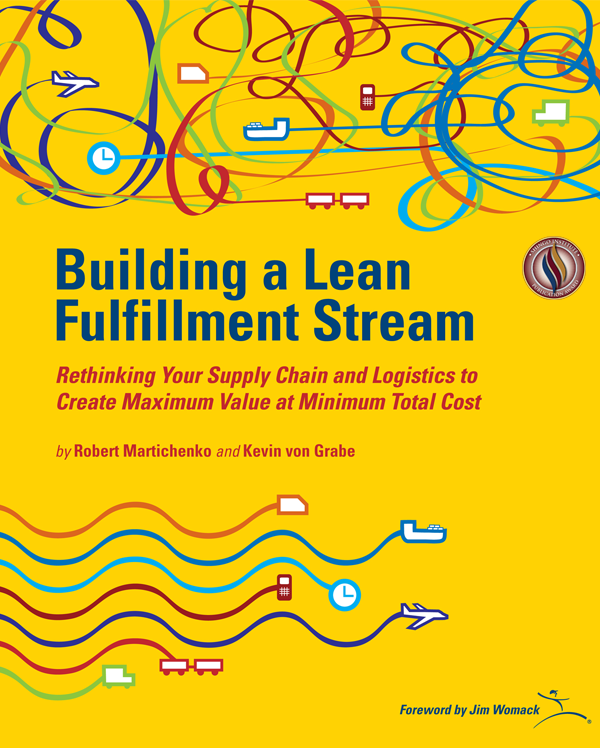Q. Why do you use the term “fulfillment stream” instead of the more common term “supply chain”?
A. Businesses traditionally have referred to this supply and shipping of materials to and from companies and customers as their supply chain. But the idea of a chain suggests something heavy, inflexible, and prone to jamming and kinking. It’s a static image, rather than a dynamic one. Within a chain it’s easy for managers to lose sight of the flow of value from start to finish, and instead focus on optimizing their one link of control, whether it’s a process, department, or even an entire firm.
To capture the lean concept of smooth flow, we prefer to envision a stream of materials flowing to the customer, with the firms and facilities along the way serving as tributaries. We call this flow of parts and products a lean fulfillment stream. It’s the flow of items from the beginning of the value-creating process all the way to the end. It includes all of the activities that move raw materials and information from materials suppliers to end customers.
Q. Why is it so important to focus on total cost of fulfillment?
A. We need to recognize that any business is a system of different departments, functions, and processes. In the absence of looking at the total cost of the system we will no doubt make decisions that minimize costs within a subset of the entire system. If we do not understand the implication of these decisions to the total cost of the system, we will likely sub-optimize and not minimize total cost.
Q. Why do you advocate using the inventory calculation of average days on hand, instead of inventory turns, which is used by many companies?
A. We use average days on hand as opposed to inventory turns because in order for us to calculate inventory carrying cost we need to understand our average days on hand (ADOH). Also, average days on hand provides us with better visibility to see opportunities. For example, if we are carrying 20 days on hand of Part 6789 but our lead time for this part is five days, it becomes visible that there is an opportunity to carry less inventory but still protect our production lines.
Regardless of the measure, it is important to look at inventory turns or average days on hand at the SKU level. Different SKUs should have different goals relative to inventory levels, different replenishment intervals and different ordering strategies. It might be perfectly acceptable for a low running, highly volatile SKU to have an ADOH of 25 while our goal for a high volume SKU with low volatility to have an ADOH of 3.
Q. What are a couple examples of common wastes in supply chains and logistics that most managers miss?
A. Trailer utilization: Most supply chain and logistics managers are told either that their trailers are full or “know” for themselves that their trailers are full. Often times they are not being fully utilized. When a trailer does arrive to their dock fully utilized it is typically a result of a “push” supply chain where the last 10% or 20% of the trailer is considered “free” and material is sent downstream regardless of a signal or trigger from the customer.
Q. What’s a milk run?
A. A milk run is a transportation move that uses dedicated equipment but has either more than on shipper or more than one consignee. It resembles a Truck Load move in that it uses a dedicated piece of equipment but is more complex in that it will not contain just one origin and destination. This transportation strategy enables supply chain and logistics managers to increase velocity within their supply chains without using the Less Than Truckload network.
Q. Why do you think companies have applied lean to internal manufacturing processes but been slow to use them in the supply stream?
A. I think there are two reasons why companies have been slow to apply lean concepts to their supply chains. First there is typically an absolute ton of work to do within the four walls of their factories. They are able to see significant improvement just by focusing on areas that are completely within their control. But, at some point on their lean journeys they will become constrained by their supply chains. In order for them to continue, they will need to apply lean principles to their supply chains and introduce their supply chain partners to lean.
Second, supply chains are complex. Often times we do not have good visibility to what is actually happening day in and day out within our supply chains. Supply chain partnerships are often short in length and agreements and contracts do not lend themselves to collaboration.
Q. In your experience, what are the biggest mistakes companies make when trying to improve supply chain and logistics?
A. The single biggest mistake that we typically see is making decisions in absence of understanding total cost. Companies often work on projects, initiatives, and blitzes that focus on a small portion of total cost. For example we often see companies focus on transportation costs by shifting modes from LTL to Truck Load without fully understanding their inventory carrying cost, the impact of increasing Lead Time, and the impact of reduced scheduling flexibility.







